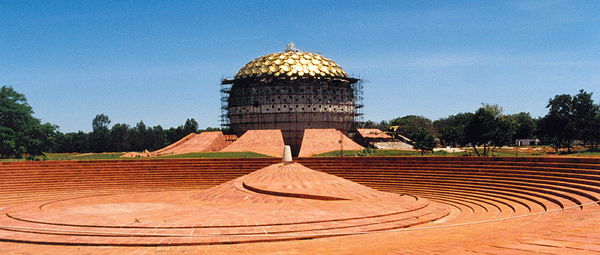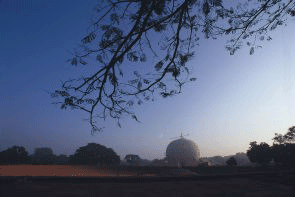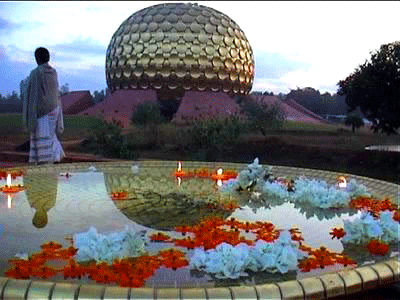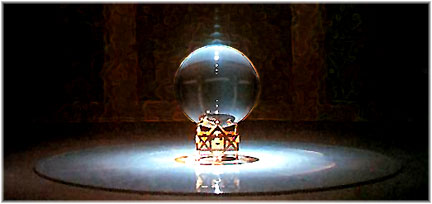MATRIMANDIR

At the very centre of Auroville one finds the ‘soul of the city’, the Matrimandir, situated in a large open area called ‘Peace’, from where the future township will radiate outwards. The atmosphere is quiet and charged, and the area beautiful, even though at present large parts of it are still under construction.
The Matrimandir is in the form of a huge spherical structure surrounded by twelve pedestals. The central dome is covered by golden discs and reflects sunlight, which give Matrimandir its characteristic radiance. Inside the central dome is the central meditation hall known as the inner chamber.
Matrimandir is was completed in May 2008 after 37 years in construction..
While walking through the lovely green Matrimandir Gardens with their great variety of flowers, shrubs and trees, one’s attention is greatly drawn by this important and powerful feature at the heart of the city which was seen by the Mother as the “symbol of the Divine’s answer to man’s aspiration for perfection” and as “the central cohesive force” for the growth of Auroville.
Evolutionary principle

The name ‘Matrimandir’ means literally ‘Temple of the Mother’. According to Sri Aurobindo’s teaching, the ‘Mother’ concept stands for the great evolutionary, conscious and intelligent principle of Life, the Universal Mother, – which seeks to help humanity move beyond its present limitations into the next step of its evolutionary adventure, the supramental consciousness.
Inner Chamber
The spacious Inner Chamber in the upper hemisphere of the structure is completely white, with white marble walls and white carpeting. In the centre a pure crystal-glass globe suffuses a ray of electronically guided sunlight which falls on it through an opening at the apex of the sphere.
“The most important thing is this: the play of the sun on the centre.
Because that becomes the symbol, the symbol of future realisations.”
There are no images, no organised meditations, no flowers, no incense, no religion or religious forms.
To find one’s consciousness…
The Matrimandir is there for “those who want to learn to concentrate..” “No fixed meditations, none of all that, but they should stay there in silence, in silence and concentration. A place for trying to find one’s consciousness.”
No religion
“Let it not become a religion”, the Mother said. “The failure of religions is… because they were divided. They wanted people to be religious to the exclusion of other religions, and every branch of knowledge has been a failure because it has been exclusive.
What the new consciousness wants (it is on this that it insists) is: no more divisions.
To be able to understand the spiritual extreme, the material extreme, and to find the meeting point, the point where that becomes a real force.”
Symbolism
The Matrimandir wants to be the symbol of the Divine’s answer to man’s aspiration for perfection. Union with the Divine manifesting in a progressive human unity.
The Matrimandir wants to be the symbol of the Universal Mother according to Sri Aurobindo’s teaching.
When viewing the Matrimandir’s structure and its immediate surroundings, the first impression it may evoke is the image of the New Consciousness breaking forth from Matter. While serious students of Auroville’s vision and endeavour may find a range of other symbolic aspects in the Matrimandir’s design, we list here some of the most evident.
The four Pillars
The four pillars that support the structure of Matrimandir, and carry the Inner Chamber, have been set at the four main directions of the compass.
“Four great Aspects of the Mother, four of her leading Powers and Personalities have stood in front in her guidance of this Universe and in her dealings with the terrestrial play”. Sri Aurobindo
In talking about the four aspects of the Mother, and their four directions, it helps to know that in India, traditionally, the evolutionary principle of creation is approached, and adored, as the great Mother, and seen as a deity. Sri Aurobindo distinguishes four main powers and personalities through which this evolutionary force manifests. The pillars of the Matrimandir have been named after these:
Maheshwari (south pillar)
One is her personality of calm wideness and comprehending wisdom and tranquil benignity and inexhaustible compassion and sovereign and surpassing majesty and all-ruling greatness.
Mahakali (north pillar)
Another embodies her power of splendid strength and irresistible passion, her warrior mood, her overwhelming will, her impetuous swiftness and world-shaking force.
Mahalakshmi (east pillar)
A third is vivid and sweet and wonderful with her deep secret of beauty and harmony and fine rhythm, her intricate and subtle opulence, her compelling attraction and captivating grace.
Mahasaraswati (west pillar)
The fourth is equipped with her close and profound capacity of intimate knowledge and careful flawless work and quiet and exact perfection in all things…

The Mother’s symbol and the Petals
The meditation rooms inside the twelve stone-clad ‘petals’ surrounding the Matrimandir carry the names and colours of the ‘petals’ in the Mother’s symbol:
These are:
Sincerity – Humility – Gratitude – Perseverance – Aspiration – Receptivity – Progress – Courage – Goodness – Generosity – Equality – Peace
“The first eight concern the attitude towards the Divine,
and the last four towards humanity.” (Mother’s symbol)
Meaning of colours
In March 1934, Sri Aurobindo indicated through the (above placed) colour chart of the twelve petals pertaining to the symbol:
– Center and four powers, white;
The twelve all different colors in three groups:
– top group red, passing to orange towards yellow;
– next group, yellow passing through green towards blue;
– and third group, blue passing through violet towards red.
If white is not convenient, the center may be gold (powder).

According to Sri Aurobindo the colours mentioned generally have the following significances, though the exact meaning may vary “with the field, the combinations, the character and shades of the color, the play of forces”:
red – physical
yellow – thinking mind
blue – higher mind
orange – supramental in the physical
violet – divine compassion or grace
gold – divine Truth
green – life
white – the light of the Mother, or the Divine Consciousness
Colours of meditation rooms
The above mentioned names and colours have been integrated into the sequence of the meditation rooms which are being completed inside each of the twelve petals surrounding the structure in the following order:
– Sincerity – light blue
– Peace – deep blue
– Equality – blue violet
– Generosity – pure violet
– Goodness – reddish violet
– Courage – red
– Progress – orange red
– Receptivity – orange
– Aspiration – orange yellow
– Perseverance – pale yellow
– Gratitude – pale green
– Humility – deep green
– Source : www.auroville.org




